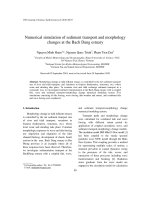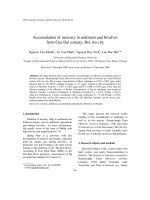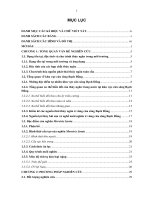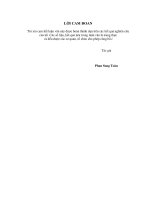Bioaccumulation of mercury in clams meretrix lyrata (sowerby, 1825) cultured at the bach dang estuary a recommendation for safe daily dosage consumption of clams in vietnam
Bạn đang xem bản rút gọn của tài liệu. Xem và tải ngay bản đầy đủ của tài liệu tại đây (48.25 KB, 1 trang )
BIOACCUMULATION OF MERCURY IN CLAMS MERETRIX LYRATA
(SOWERBY, 1825) CULTURED AT THE BACH DANG ESTUARY: A
RECOMMENDATION FOR SAFE DAILY DOSAGE CONSUMPTION OF
CLAMS IN VIETNAM
Le Xuan Sinh1*, Mai Hương2
1
Institute of Marine Environment and Resources, Vietnam Academy of Science and Technology, 246 Đa
Nang, Hai Phong, Viet Nam
2
University of Science and Technology of Hanoi, Vietnam Academy of Science and Technology, 18 Hoang
Quoc Viet, Cau Giay, Ha Noi, Viet Nam
*
Email:
Received: 18 October 2019; Accepted for publication: 4 May 2020
Abstract. This study assessed the level of total mercury (THg) and methylmercury (MeHg) in seawater
and clams Meretrix lyrata (Sowerby, 1825) during all four seasons (July 2010 to May 2011) at the Dong
Bai intertidal area in the Bach Dang estuary. The results showed that THg and MeHg concentrations of
the water were under the allowable limit. THg and MeHg concentration for clams ranged from 12.5-87.9
ng/g dw and 1.1-24.6 ng/g dw, respectively. The highest bioaccumulation factor (BAF) of Meretrix lyrata
was 303.2 for THg and 165,000 for MeHg. The recommended safe dosage for daily clam consumption
depends on the season. Over an one-year period, mercury contamination in clams harvested in the Bach
Dang estuary ranged from 1.4 to 38.1 g/kg bw. It is not recommended to consume too many clams in
March or April.
Keywords: Meretrix lyrata, accepted daily intake, bioaccumulation factor (BAF); methylmercury;
total mercury.
Link: />









